Beautiful and refined room flower, Gloxy Blanche de measure, stands out of velvet green foliage and large "flowers-bells" of raspberry and snow-white colors. Many flower flowers attracts the unusual refined beauty of this plant, blooming throughout the summer period. How to grow a flower at home, what to provide him with the conditions of care and how to breed "beauty-Gloxinia," - read this article.
Gloxinia Blanche de Mere, description of the plant
- Glocking was named after Glockin's German nerknia. The species diversity of the genus is represented by perennial tuber plants, more often with a short stem and oppositely located leaves. The main decoration of any kind of gloxy is bright single velvet flowers, large sizes and bell-shaped. Seeds are small, ripen in large quantities.
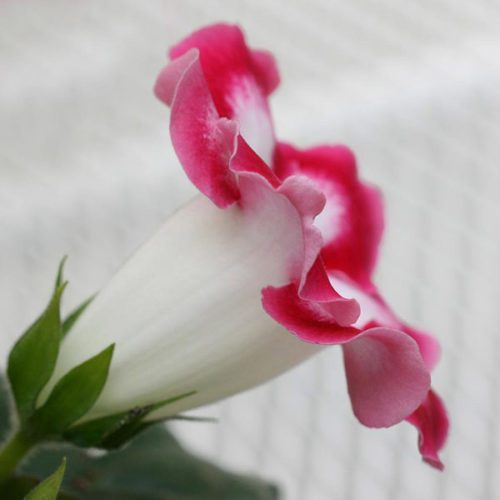
- A variety of Gloxinia Blanche de Mere is impressive by the beauty and grazing of 5 petal flowers - "gramophilics". The snow-white center of the bell tower of a prominent flower is bold a bright pink wavy framing, and the boundaries between the colors are not clear, blurred. Such color emphasizes the depth and tenderness of a large flower reaching in diameter 12-15 cm.

- Flowers grade Gloxinia Blanche de measure quite a long period: from May to August. Speecually and elegantly looks home plant, "releasing" a whole bouquet of magnificent flowers, bordered green foliage. One bush of Gloxinia is able to form simultaneously up to 20 flowers.
- The plant is low, compact, reaches a height of not more than 20-25 cm. Large oval leaves of saturated green color are distinguished by a pleasant velvet input with silver streaks.
- The root system of Gloxinia is represented by tubers. For the plant is characterized by a life cycle with 3 main periods: peace, active growth and flowering. The rest period flows in winter when the bedroom flower completely ceases to develop, the leaves dry, and the tubers "freeze" and are subject to storage. In the spring, the tubers are planted again into the updated soil.
- Interesting translation of the name of this grade of Gloxy. In Russian, the phrase "Blanche de Mere" literally denotes "blood with milk" and symbolizes not only the bright color of the flower whites, but also a high resistance of the plant. Indeed, culture is considered a very hardy, well-carrying arid period.
- Flower is used as a beautifully blooming room plant.

Gloxinia Blanche de Mere, conditions of successful cultivation
Features of the life cycle of Gloxinia suggest certain rules for landing and competent care of the room plant.
To the flower pleased with lush, abundant and timely flowering - it is important to know the rules for planting a tuber culture and choose the best place in the house for Gloxy.
Under favorable conditions, Gloxinia live no longer than 4-5 years.
Gloxinia Blanche de Mera - Flower location
Place for a pot with a flower of Gloxinia is chosen depending on the preferences of the plant, the time of year and the climatic zone of growth.
- Room flower, light-loving gloxia, prefers well-lit places in the house. With a lack of light, the plant is drawn up, sluggish, bloom worsens and mines, and the color of flowers and leaves will noticeably fade. At the same time, the Gloxinia Blanche de modee needs to be shared from the scorching midday sun, otherwise it is fraught with foliage burns and the possible flower death.
- Depending on the season, you can change the location of the flower pot. In the spring - it is safely exposed to the southern side of the windows when the plant enters the phase of active vegetative growth and formation of uncess. Hot summer is better to rearrange the pots with Gloxinia to Western or Oriental windows. You can leave the flower and on the south side, subject to its shading or accommodation from the window and scorching sunlight. Having a flower on the northern windows, you will need additional lighting (lamp), allowing you to increase the light day at least to 12 hours.
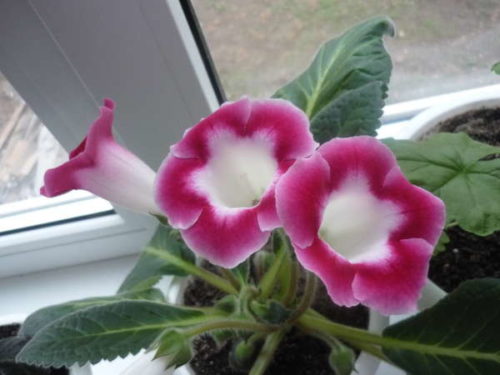
Gloxinia Blanche de Mere - Conditions of Growing
- Poor reacts the flower of gloxinia and on sharp differences of temperature regime. The optimal temperature in the plant for the plant in the warm season is 18-23 0C. In a cooler room, vegetation slows down, there is no bloom, the plant begins to hurt and can die. Also as low, not desirable and too high, for example, 25-30 0C. Long-term overheating of the tuber leads to a violation of the development of indoor flower. During the winter rest, tubers are stored at a temperature of 10-14 0WITH.
- Flower should be removed from the place where the draft is often observed. Gloxia prefers cozy and protected, from wind, place on the windowsill.
- Successful cultivation of Gloxinia Blanche de Mera also depends on air humidity. The optimal level of humidity for the flower is 70-80%. The lack of humidity negatively affects the turgor of the leaves of Gloxinia, they are withering and "hang" down. To increase the level of humidity, the flower pot is placed in the pallet with a moistened clay or pebbles. To increase the humidity, it is also possible to simply put additional water containers on the windowsill.

Gloxinia Blanche de measure, landing features
The flower of Gloxinia needs an annual transplantation in the spring when the plant "awakens" after the winter. During this period, the active cycle of Gloxinia, the first sprouts and roots appear on the tubers of Gloxinia. As a rule, the plant begins in growth already in February-March. Each year for landing is used fresh ground.

Choosing a flower pot for Gloxinia Blanche de Mere
- The flower pot for this grade of the Gloxy is chosen wide and not too deep, because the roots of the flower are growing styling.
- Too spacious containers contribute to the development of green mass and plant roots, while the formation of buds and the flowering directly shifts at a later period.
- In order for Gloxinia to please the surrounding picturesque flowers, her tubers must be in the "cramped" condition. So, for a young plant, a pot is only 10 cm in diameter, and for an adult long-flowing copy, with good tubers - a sufficient capacity of 15 cm wide. Usually, the diameter and height of the flower pot for gloccia are the same.
- Landing container can be ceramic or plastic.
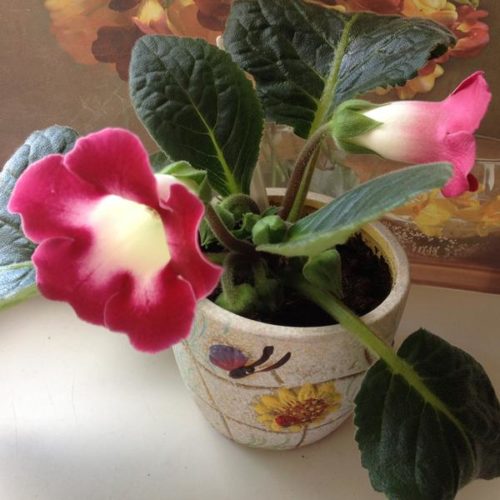
Gloxinia Blanche de Mere - Preparation of planting material - tubers
- If the tubers after storage seem lifeless, you should not land the ground, since the risk of pinning them. It is better to wait for the natural "awakening" of the plant or try to activate the fastest germination. For this, the tubers are placed in a dense transparent package with barely moistened peat, close it and expose to a warm and well-lit place. Light provide at least 12 hours, temperature - about 25 0C. So, without venting, tubers are left until germination. At first, water drops will appear on the walls of the package, then the club growth point will be crossed and the first sprouts will appear. Such, artificially "awakened", the flower, as a rule, does not lag behind other Gloxins, demonstrating active growth and abundant flowering.
- If, after wintering, the tubers "wrinkled", they are placed for several hours into the solution of the growth stimulator (by the type "epin" or "zircon"), but so that the sprouts remain dry. People dried after this manipulation already in a day will be ready for landing.
- When, as a result of the above-described "resuscitation" actions, the tuber still "does not wake up" - it is cut and inspect. The core of brown testifies to the final death of the tuber. If the tuber is partially touched by rot, you need to cut all brown areas, treat sections with greenflash (activated carbon), soak the remaining part in any growth stimulator and plant the treated tuber in the ground.
- In the case when "wintering" sent too young tubers, which did not have time to gain sufficient mass, such copies, as a rule, die. This threatens and too old landing material.
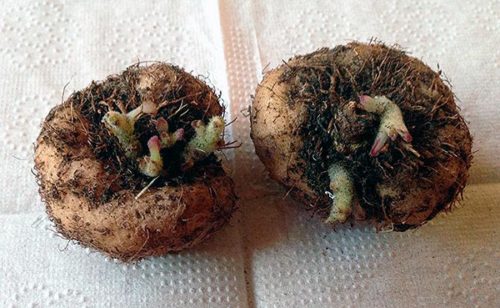
Agrotechnology planting tubers in Gloxinia Blanche de measure
- Immediately before landing, all the blocming tubers carefully examine, remove the extra flakes, cut off (if any) faded areas, and the sections of the sections are processed with crowded activated coal. Then, in order to prevent the development of rot, they are soaked for half an hour in a solution of potassium permanganate (manganese) and leave to dry out for a day.
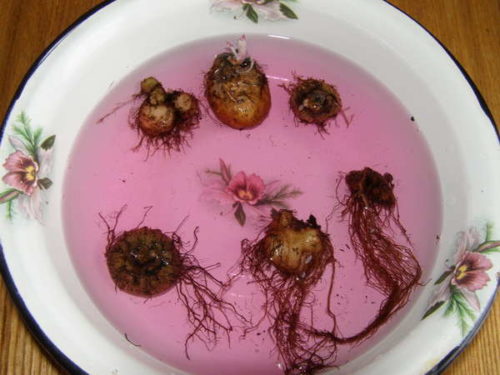
- The soil for planting Gloxinia is prepared from sheet (sod) earth, humid, sand and peat in a ratio of 4: 2: 1: 2. It is recommended to add to the cooked soil a little safagnum moss. Such a loose and light nutritious substrate is the best environment for the roots of Gloxinia. You can also buy a ready-made soil intended for flowering plants: violets, begonias or sensipolium.
- When planting a plant, a 2-3 cm drain layer is necessarily placed on the bottom of the flower pot. To do this, use fine pebbles, crushed stone, clayjit or eggshell. Thus, it is possible to securely susceptible to the excess moisture, the roots of Gloxinia from Harlings.
- A tuber is planted in the prepared substrate, with a blowout on 2 \\ 3 of its lengths, so that the upper part remains not covered.
- The soil (around the tuber) is moisturized, the pot is covered with glass or film and placed in a bright place. Before the appearance of the first sprouts and leaves, the pot is twice a day open to ventilating (30 minutes in the morning and in the evening).
- When the first pair of gloxy leaves appears, the shelter is removed, and the soil mixture is added to the flower pot (until the tuber is completely coated).

Gloxinia Blanche de measure, plant care
Gloxinia Blanche de Mere is considered a rather capricious indoor plant in need of regular irrigation, feeding and winter period of rest. To provide a plant, comfortable cultivation conditions should be aware of its basic preferences.
Watering Gloxinia Blanche de Mere
- The care of Gloxinia Blanche de Mere is regularly and abundant irrigated with a slightly warm dilated water.
- When watering, it is important not to fall onto the point of growth of the indoor flower (in the middle of the bush) and not allow moisture stagnation, as this can lead to a platter.
- It is best to carry out from the bottom, through the pallet. Moreover, no extra water will not leave for a long time, but pour.
- Watering is carried out as the earth dries in the pot. For Gloxinia, it is better to "not add, than to pour."
- After the flower flashes, the irrigation rate is reduced, and when all the leaves are dried - and stop at all. So, Gloxia is preparing for the winter period of rest.
- To spraying, the pubescent leaves of Gloxinia are picky, so it is not desirable to spray water on the plant. If I had to resort to this procedure, it follows the water only around the flower, without falling on it, and for spraying, use a small pulverizer.
Making fertilizers and feeding of Gloxinia Blanche de measure
- Positively spoke room flower and nutritional feeders.
- Special fertilizers intended for decorative-blooming crops stimulate the growth of green mass and ensure lush flowering.
- Fit Gloxinia should follow 1 time in 2 weeks, alternating organic and mineral fertilizers.
- The best time for making feeding - after watering, in the morning or evening.
- In the most active period of growth (before the appearance of buds) use nitrogen fertilizers to strictly specified norms. With nitrogen should be particularly attentive, as its oversupply is destroyed for a flower.
- In the period of bootonization and directly flowering, potash-phosphoric additives are suitable. These elements contribute to abundant and decorative flowering.
- At the beginning of autumn, for successful wintering, the plant needs a superphosphate (or mono phosphate) potassium. Autumn feeding is the last, after which Gloxy is preparing for the winter period of "hibernation".
- If the gloxinia lacks nutrients - the plant slows down in growth, the leaves are flexible, the flowers are minced, the duration of flowering is also reduced. Overdose fertilizers is also extremely dangerous and disadvantaged for the plant. Therefore, using one or another drug as feeding, it is important to carefully study the instructions and the norms specified on the package.
Fighting diseases and pests of Gloxinia Blanche de measure
- The most common cause of the disease and the death of the plant is the development of rot. That tubers are not affected by rot, the soil before planting the gloxy is treated with a microbiological preparation (for example, phytosporin-M). At first, after landing, you can also add this drug to water for watering Gloxinia.
- It should be remembered that the root cause of the appearance of rotes is excessive mooring of the soil, irregular watering (on the core or leaves of the bush) or use for watering cold water. Compliance with all rules of care will ensure the development of a healthy and beautiful room flower.
- If a web appeared on the leaves of Gloxini, brown spots, and they began to twist - the plant "suffers" from the pawitone tick. Insecticidal drug, which splashes a plant three times, with an interval of 4-5 days will help in the struggle.
- In summer, a plants are damage to small insects - TRIps. The characteristic feature of the presence of pests are gray spots on flower flowers and buds. To get rid of insects - the affected parts of the plant are cut, and the ground and the leaves are treated with a system insecticide (for example, "Aktara").

Preparation of tubers for the rest period of Gloxinia Blanche de Mere
- Approximately by the middle of autumn, in October, Gloxinia begins to prepare for the rest period: the leaves and stalk yellow, faded and dried.
- At this time, the watering is reduced, and the feedstocks are completely stopped, the stem and leaves are cut off, leaving the "funeral" about 2 cm above the ground. The pot with Gloxinia still watered about 2-3 weeks, but they are rarely done in small doses.
- At the end of the autumn, tubers are ready for such an important period of their life cycle, as a period of peace, which will last about 2-3 months. Start early to bring the tubers from the "winter hibernation", since then the flower will grow weak and non-visual.
- In order for the blocming clubs painlessly survived the rest period and did not dry, it is important to store the tubers properly.
- There are several ways to preserve tuber in winter:
- The tuber is getting out of the pot, purified from soil, processed by any antiseptic and laid into a plastic container with moistened sand. Tubers are stored in a dark cool place, with a temperature of about 10-12 0C (for example, in the basement).
- Dugged tubers are placed in a plastic bag (with a "lock") filled with vermiculitis and soil in a ratio of 1: 1. The package is tightly closed and placed on storage in the refrigeration chamber.
- Tubers do not dig, leave to winter in a flower pot, which fall asleep with dry sand (up to the very edges) and transfer to a dark cool place, for example, in a basement. In winter, it will be necessary (1-2 times a month) a little pour a pot with Gloxinius so that the tubers do not dry. It is impossible to allow moisture stagnation, otherwise the tubers are charged.
- Sometimes, a weak flower of Gloxinia is not sent at all on "peace" and leave to winter, providing a plant with watering, power and additional backlight. To determine the level of viability of the plant, it is quite autumn to recalculate its leaves. If there are less than 6 pairs, the flower leaves to winter as ordinary room plants, continuing to stimulate their growth and development. The next year, fastened gloxinia will return to a normal life cycle, with a period of flowering and natural winter peace.
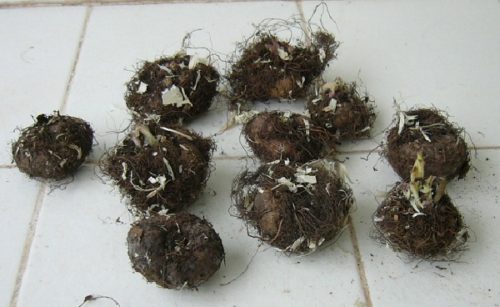
Problems when growing Gloxinia Blanche de Mere
Consider the most common problems in caring for homemade Gloxinia.
- Gloxinia crushes leaves. The reason for such a trouble can be a draft in the place where the flower is located in the air, insufficient lighting or "attack" of the web tick.
- Gloxinia is drawn up. The main reasons are the lack of light or high temperature in the room.
- Gloxinia does not bloom. The cause of the plant or lack of nutrients in the soil can be the cause.
Reproduction of gloxy Blanche de measure
If the tubers became old or died during the winter peace, it is worth thinking about the further breeding of the room plant.
Gloxinia Blanche de Mera multiplies with seeds, tubers, leafy and stem cuttings, leaf fragments.
Seed method of reproduction of Gloxinia Blanche de Mere
- The reproduction of seeds is a rather long and time consuming process. Small seeds and seedlings that appeared quite capricious in germination. This method is most appropriate when removing new Gloxinia varieties. At the same time, successfully sprouted Seeders of Gloxinia will bloom about six months.

- Seeds can be bought or assembled with houses available in the house.
- An independent seed collection is preceded by artificial pollination of flowers. For this, the cottage (or tassel) is alternately touched into every Pestka of Gloxinia to type and transfer pollen.
- In case of successful fertilization, seed boxes will appear on the flowers. To collect the ridden seed material, the boxes with seeds are cut as soon as they begin to open (about a week after the flow of petals of the flower of Gloxinia).

- The best time for sowing seeds is the second half of winter. If the seeds are heated in the fall - it is important to freeze seedlings and provide them with the necessary temperature regime. Otherwise, seedlings will be elongated, thinned and weak.
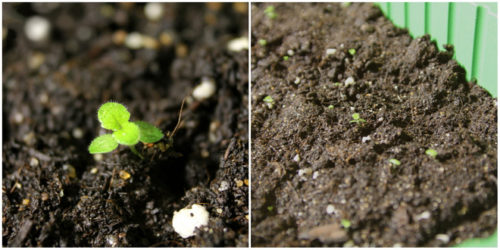
- For sowing seeds into the container, 1 cm of drainage (for example, clay) is poured, the mixture (with a peat content). On the moistened, from the pulverizer, the soil seeds seeds (with the help of a bent sheet of paper).

- The container with seeds is covered with a transparent lid, glass or film and placed in a warm light. After about a week, shoots will appear, and a month later the seedlings are pyric in a more spacious capacity.
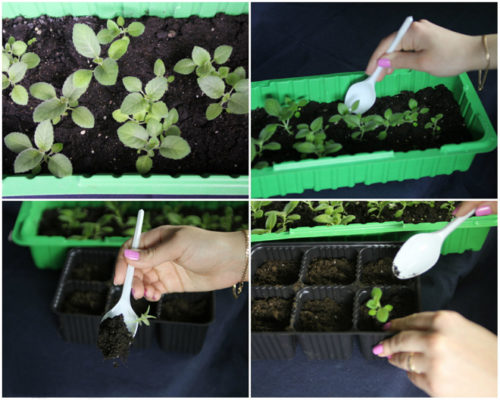
- When the leaves in the width grows up to 2 cm, the seedlings transplanted into separate cups.
- The main care, both behind the seeds and the seedlings, is constant moistening, sufficient lighting and temperature indoors.

Vegetative method of reproduction of Gloxinia Blanche de Mere
- You can propagate glocking with a leafy of an adult plant. To do this, choose a healthy intact sheet with a cushion length more than 1-2 cm, which is placed in water tank for root formation. The sheet with appeared roots is planted in a loose soil (with the addition of peat and sand). The container with a sheet is covered with a glass jar and provide daily ventilation and moisturizing (as needed).
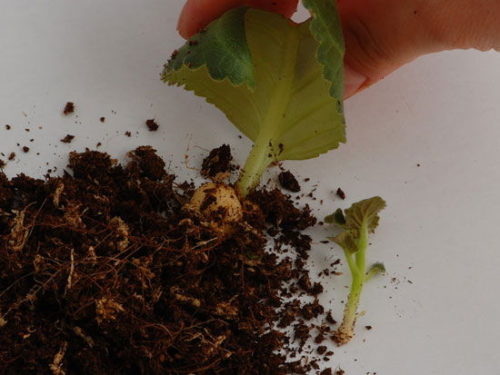

- In addition, the most common method, the gloculation is multiplied with a part of the sheet. Large sheet plates of gloxinia are divided into parts and placed in a wet medium for the formation of roots. Another option - from the bottom side of the large sheet there are several cuts and put it in a wet substrate (base down). On top imitate the "greenhouse effect", covering the sheet with a can, and leave in a warm place (at least 20 0WITH). The soil regularly moisturize and, when roots appear, the plant is transplanted into the flower pot.
- The reproduction part of the Gloxinia tubers is considered ineffective and is not used in flower growing. If you use this method in practice, it is necessary to use large born tubers. The tuber is divided into parts by the number of processes available on it. Cut the strawberry with a sharp knife, after which the sections are treated with activated carbon powder. After the manipulations were carried out, the tuber's part is planted into the moistened soil. Watering starts 2-3 days after landing.
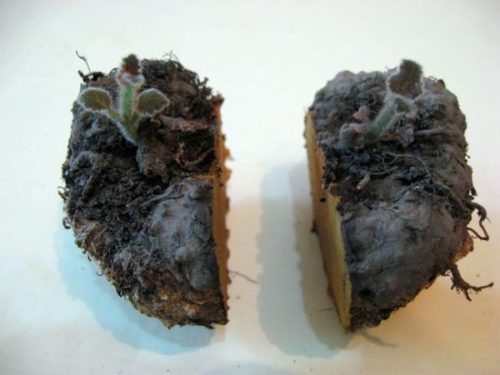
Thus, having considered the features of landing and care for Gloxinia Blanche de Mere, the following conclusions can be drawn:
- The amazing beauty, the flower of Gloxinia Blanche de mode, requires increased attention and knowledge of the life cycle of the room plant.
- The bloom of this type of Gloxinia is one of the most spectacular, abundant and long-term among many other flower crops.
- Gloxinia Blanche de Mere, over 4 years old, require updates and reproduction by any of the above methods.
- Of course, adapting to the preferences of the culture and studying the peculiarities of its cultivation at home - the care of Gloxinia will turn into a fascinating and fascinating process of creating beautiful.

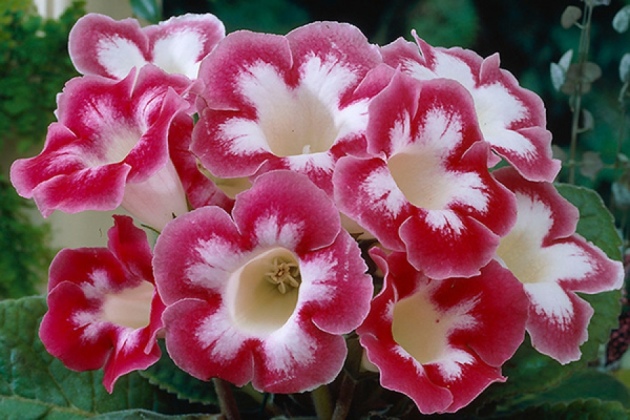
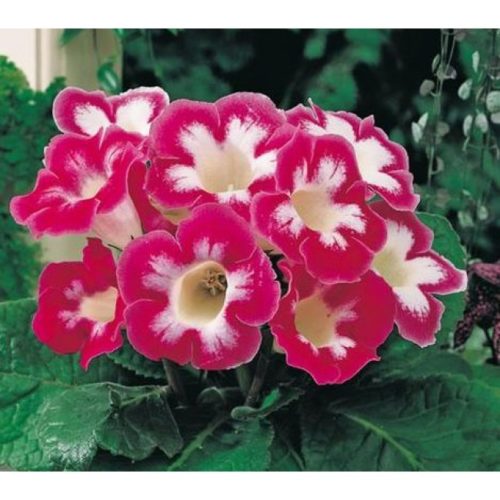


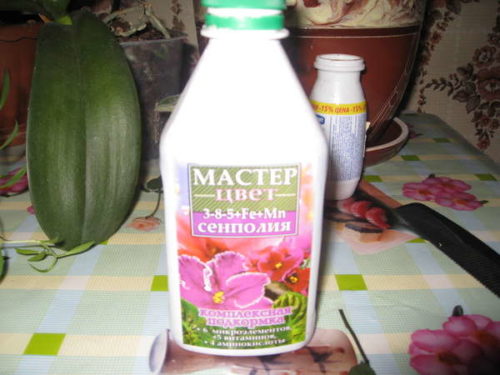

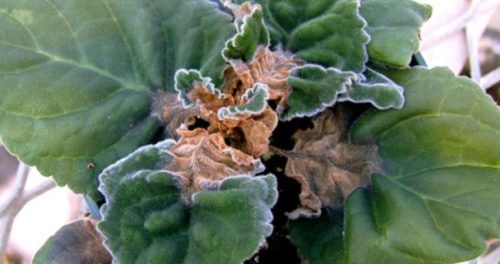

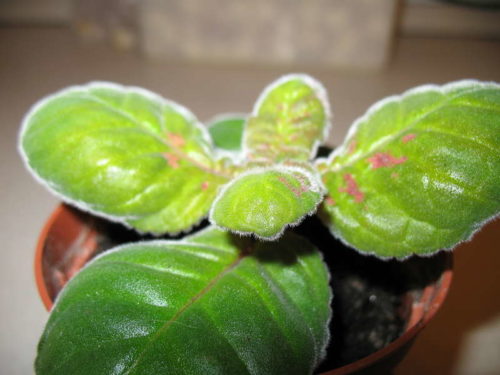

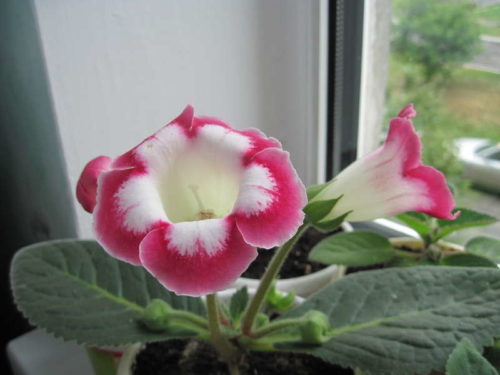
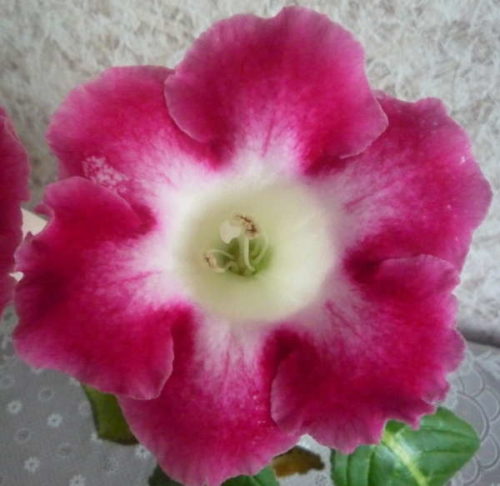
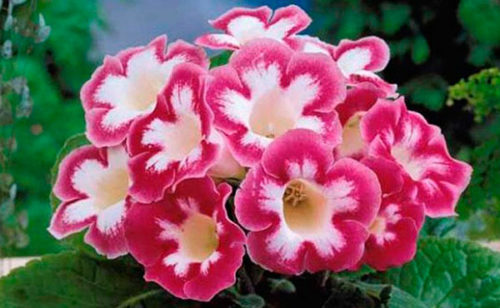
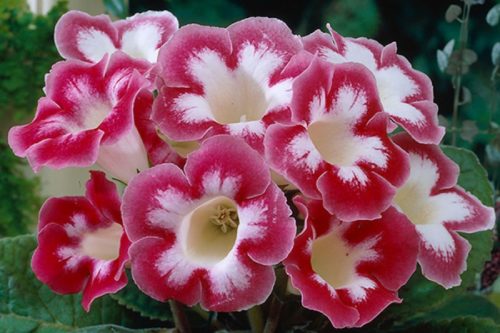












 Start a discussion ...
Start a discussion ...